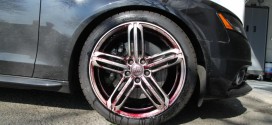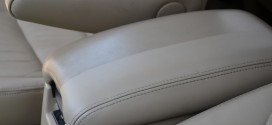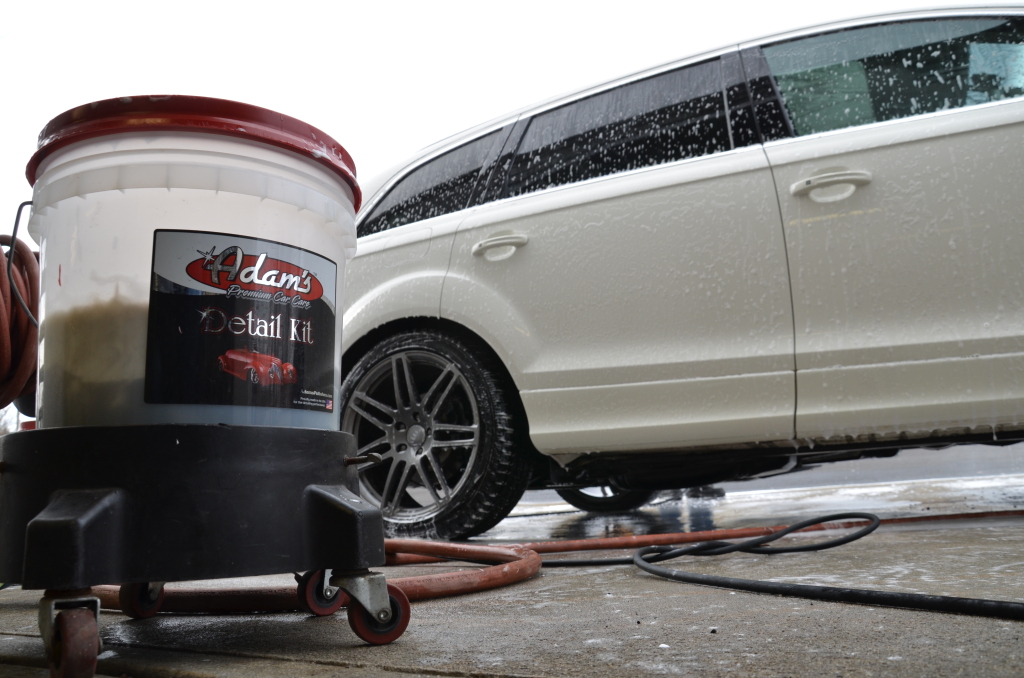Choosing the correct buffing pad is critical ….by Kevin Farrell
In last month’s issue, I spoke about the importance of buffing products and the need to know what they can do. If you have products that you are familiar with, the other item that is just as important to the buffing process is the buffing pads. Your choice of buffing pads is just as critical as your choice of buffing products, and you must know exactly what each can do.
The type of pad you choose when buffing a car will make a huge difference in the overall appearance of the paint finish when the car is completed. There are various reasons for this. First you must know the aggressiveness of the compound or polish you are working with. I urge you to get familiar with your buffing products and know what they can and cannot do in regards to paint correction. With that variable known, you must also realize that not every paint system will react the same way when buffing it. Therefore, your choice of buffing pad needs to be based on the product you are using, the type of paint, and what you need to accomplish in that particular buffing step.
Not all paints are the same
Most of the cars you will be working on have a basecoat/clearcoat paint system. As a detailer, you will be buffing the clearcoat portion of the paint. Some clearcoats react differently when buffed, even when your choice of product and buffing pad remains the same. Paint chemists refer to the difference in clearcoats as cross link density. The denser the clearcoat is, the harder it is. Less dense clearcoats are softer. One is not necessarily better or worse than the other, but a detailer must be aware that all clearcoats do not react the same way when buffing. When buffing a softer clear, you may have an easier time removing scratches and blemishes, but you may leave behind deeper swirl marks and more of a haze or cloudiness in the surface. Also, the danger of burning the paint is greater on a softer clearcoat. This type of clear needs less aggressive buffing and a less aggressive choice of buffing pad. A harder clearcoat will pose more of a difficulty in removing scratches and blemishes. This type of clear will need more aggressive buffing and a more aggressive choice of buffing pad. So, keeping in mind that all paints react differently to buffing, you will probably need a variety of buffing pads to produce a perfect finish on each and every vehicle.
By hand or by pad?
With today’s paint finishes, you almost certainly will have to use some type of buffer and buffing pad for optimum results. The days of getting a flawless finish doing everything by hand are over. Why would you want to perform the whole job by hand anyway?
Applying a product by hand wastes time and product, and will never produce the desired results that a buffer and pad will. Some detailers may be afraid of the damage that a buffer and pad can do if used incorrectly. Therefore, they work by hand. Some of the damage caused by high speed buffers are the direct result of not knowing what each pad can do to the paint surface. Let’s look at the different pads and what each one can do.
Types of buffing pads
There are 2 groups of buffing pads that can be used to buff a paint finish. Within each group are numerous choices. The first group of pads are Wool pads. There are a wide variety of wool pads to choose from. The jobs they do vary and include heavy cutting or compounding, light cutting, polishing and finishing. The pad may be made of 100% wool, a blend of wool and synthetic, or natural lamb’s wool for finishing purposes.
Cleaning of the wool pad
Keeping the buffing pad clean is a must for consistent, smooth buffing and a quality finish. The best way to clean a wool pad is to let the residue from the polish or compound fully dry and use only a “spur” tool to clean it. Some detailers use screwdrivers. Don’t clean a pad this way. It is dangerous and may rip up the wool.
Foam pads
The second group of pads are foam pads. They have come a long way in the last few years. Their job descriptions range from cutting, to polishing, and finishing.
The aggressiveness of foam pads are judged in a couple of different ways. The first way is to obtain its grading. Foam pads are graded in PPI or Pores per square Inch. Most foam pads range between 40-100 PPI, with a higher grading or PPI usually signifying a softer pad. To further explain PPI, if you magnify a foam pad it will look like a honeycomb. The more cells or pores there are per inch, the higher the PPI rating. The less cells or pores per inch would give that pad a lower PPI rating and will tend to make that pad a bit more aggressive.
The second variable in judging the aggressiveness of a foam pad is its density and compression. There are many different types of foam densities available to pad manufacturers. The combination of pad density, compression and PPI will ultimately determine the aggressiveness of the foam pad. Never judge pads aggressiveness solely by its color. Some companies use similar colors for their pads but the aggressiveness can be totally different. A very aggressive pad would typically have a PPI rating of 40 or 50 and would be fairly dense in feel. Light cut pads would be a 60-80 PPI and have a softer feel but still somewhat dense. Finishing pads are closer to 100 PPI and feel very soft.
Cleaning of foam pads
To clean a foam pad, you will frequently need to spin the pad while on the buffer and use a nylon bristle toothbrush to remove excess product. You NEVER want to use a spur, screwdriver, edge of a countertop, etc to clean a foam pad because it will immediately destroy the pad. It is also not recommended to wash foam pads in hot water and dry them in a clothes dryer. The heat will sometimes delaminate the glue that adheres the Velcro to the back of the pad. This will cause the Velcro to separate from the pad and it is nearly impossible to reattach it once it separates.
Know what each pad is capable of
Knowing the descriptions and characteristics of both wool and foam pads should help you in understanding what each type of pad can accomplish in the buffing process. In your arsenal of buffing pads you should be able to grab any type of pad and know exactly what that pad will do to the paint surface.
The more aggressive pads are designed to “shave” the paint of its imperfections, while still being able to produce a degree of gloss. The lighter cut and polishing pads are designed to finely buff and shine the paint surface to give it a brilliant appearance. Some of the more aggressive pads can damage the paint if care is not taken. An aggressive pad will also damage moldings and other sensitive trim if used incorrectly.
Finishing pads won’t pose a serious threat of damage paint and moldings, but they can’t be used exclusively just because a detailer may be afraid of damaging something. That is, a finishing pad really should not be used for compounding; the same as compounding pads should not be used for finishing. Trying to use one type of pad for everything is counter productive to what you are trying to accomplish. The results will not be what you want. However, there are instances when you can overlap uses for some pads and be extremely successful. Let’s examine the possibilities.
Up and down the ladder
You can take the buffing products that you have and make them more or less aggressive by your choice of buffing pad, and/or speed and pressure exerted on the buffer. I call this moving up and down the ladder. I keep things simple in my shop. I use only one compound and only one polish. I don’t see a need to have 2 or 3 different compounds and 2 or 3 different polishes. I know the capabilities of my products and I can adjust what they can do by changing pads. The compound needs to work with your most aggressive pad to remove the harshest imperfections. This is the top end of the ladder as far as aggressiveness. I have an excellent compounding foam pad (50PPI and fairly dense) that works well with my compound at a fairly low speed. For most applications I can use this foam pad with my compound and it will remove most scratches and blemishes. If I want the compound to perform a bit less aggressively, I will simply use a medium foam pad (60PPI with medium density). This limits the overall aggressiveness of the compound. The speed and pressure exerted on the buffer also comes into play. At 1500 RPM and more pressure, you will be more aggressive than at 1000 RPM and little pressure. So there is quite a bit of leeway involved by working with the same product, but choosing a couple of different pads.
Using the polish I can do the same thing. I can go up the ladder of aggressiveness by using the 60PPI, medium dense pad and slightly more speed and pressure, to be slightly more aggressive to accomplish tasks such as removing deep swirl marks. I can go down the ladder and use a 90 or 100 PPI pad that is very soft with less speed and pressure and be less aggressive, as in final polishing.
Some detailers question my simplistic approach and wonder how I can work with only 1 compound, 1 polish and 3 different choices of pads. However, 95% of the time I have no problem removing imperfections, swirl marks, and creating a showroom new finish with what I choose to use. I simply move up and down the ladder with my choice of pads.
Specialty pads
You may have seen some of the specialty pads that are out there such as 3 inch wool or foam pads for very tight areas. Many of the car manufactures use these very small diameter pads to quickly buff minor imperfections in the paint after the vehicle has been painted. The small diameter pad limits the amount of buffing and precisely buffs the area in question. I sometimes use a 3 inch foam pad to polish door jambs or very tight areas where control and accuracy is the key.
I am also a huge fan of 6 inch pads. While some detailers would consider these pads a specialty pad, I do not. I use them each and every day. I have buffed with 6 inch pads exclusively for years. They are available from many buffing pad companies and come in the same type of foam grades as the larger 8 or 9 inch pads. They offer far greater control of the buffer and get into small areas where a larger pad cannot fit, or may be dangerous to use, such as around door handles, moldings and trim. I find it easier to keep even pressure on the buffer with a 6 inch pad. This allows me to keep the pad flat to the panel for optimum performance and maneuverability.
There are other “specialty” pads or “gimmick” pads out there that I feel do not enhance the buffing process. Some companies try to be different for competitive reasons, and they produce pads that are very different from the average pad. You will have to be the judge of the usefulness of these pads.
Regardless of the style of pad you choose to buff with, or its manufacturer, you need to know what the pads capabilities are. Get familiar with each and every pad you have, as well as the buffing products you use. With extensive knowledge of both buffing products and buffing pads, you will be well on the way to producing flawless looking vehicles.
 Detailer's Domain The Source for All Your Car Care Needs
Detailer's Domain The Source for All Your Car Care Needs



